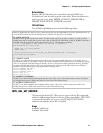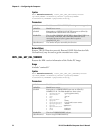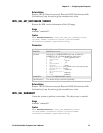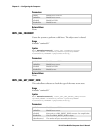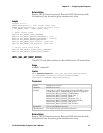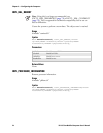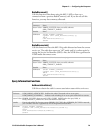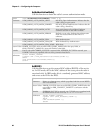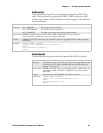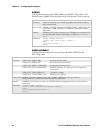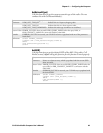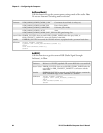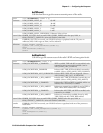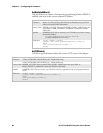
Chapter 3 — Configuring the Computer
751G Color Mobile Computer User’s Manual 79
RadioDisconnect()
Call this function when done using the 802.11 API to clean up a
connection from a previous RadioConnect() call. If you do not call this
function, you may leave memory allocated.
RadioDisassociate()
Call this function to have the 802.11b/g radio disassociate from the current
service set. The radio then enters an “off” mode until it is woken again by
setting the Service Set Identifier (SSID). Also, the NDIS driver generates an
NDIS media disconnect event.
Query Information Functions
GetAssociationStatus()
Call this to obtain the radio’s current association status with a service set.
Syntax UINT RadioDisconnect( );
Parameters None.
Return Values ERROR_SUCCESS when successful, otherwise
ERR_CONNECT_FAILED
Remarks None.
Definitions
#ifdef DYNAMIC_LOADING
typedef UINT (*PFN_RadioDisconnect)();
#else
UINT RadioDisconnect();
#endif
Syntax UINT RadioDisassociate( );
Parameters None
Return Values ERROR_SUCCESS when successful, otherwise
ERR_CONNECT_FAILED.
Remarks None
Definitions
#ifdef DYNAMIC_LOADING
typedef UINT (*PFN_RadioDisassociate)();
#else
UINT RadioDisassociate();
#endif
Syntax UINT GetAssociationStatus( ULONG & );
Parameters NDIS_RADIO_ASSOCIATED
NDIS_RADIO_SCANNING
Indicates the radio is associated with an access point
Indicates radio is looking for an access point with which to associate
Return Values ERROR_SUCCESS when successful, ERR_QUERY_FAILED when the query failed, or
ERR_CONNECT_FAILED if a connection with the radio failed.
Remarks Data is only valid if the function returns ERROR_SUCCESS. Also, if ERROR_SUCCESS is returned,
your ULONG reference is populated by one of the parameters listed above.
Definitions
#ifdef DYNAMIC_LOADING
typedef UINT (*PFN_GetAssociationStatus)(ULONG &);
#else
UINT GetAssociationStatus(ULONG &);
#endif



